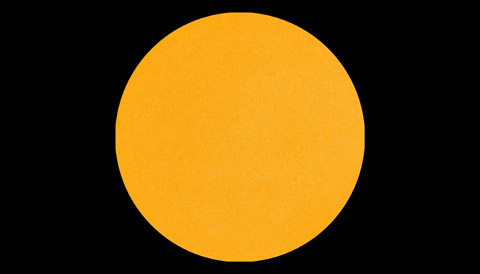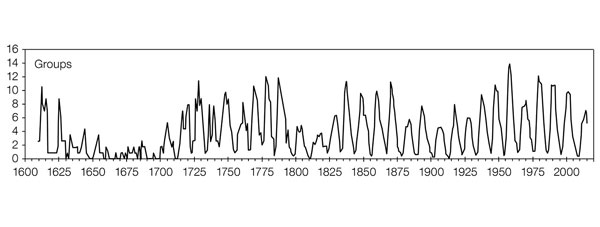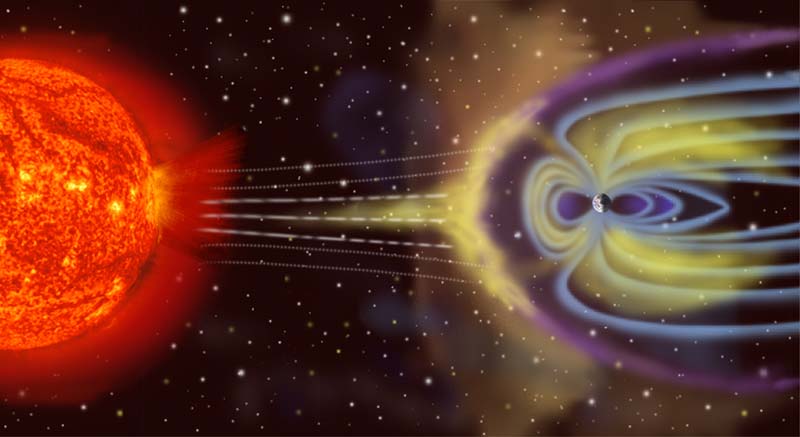If the Sun goes spotless in decades to come, as some scientists are predicting it might, what does it mean for Earth? Scientists are studying the past to predict the future of space weather.

SDO/HMI
In 1645, the sun became nearly spotless. During the 70-year period that followed, known as the Maunder Minimum, sunspots appeared only rarely on the surface of the Sun. Now, after a peak in magnetic activity that drove the appearance of a multitude of sunspots during the 1950s and 60s, the Sun again appears to be headed toward such a minimum.
Yet it's not always a bad thing when history repeats itself — it means that we can study the past to predict the future. And that’s just what scientists such as Mathew Owens (University of Reading, UK) are doing. In Nature's January 31st Scientific Reports, Owens and colleagues look back to the Maunder Minimum in order to anticipate solar and auroral activity (or the lack thereof) in our near future.
Then and Now
The Maunder Minimum* was named after solar astronomers Annie Russell Maunder and E. Walter Maunder who first discovered the extended period of abnormally low sunspot reports. During this time, the Sun continued its 11-year cycle of activity, with its sunspot count rising to maximum and falling to minimum again. However, even with Giovanni Cassini, Johannes Hevelius, and several others regularly observing the Sun, only a couple dozen sunspots were recorded over a 70-year timespan.

WDC-SILSO
And in recent years, it has become apparent that the modern era seems to be headed toward a minimum of sorts, too. The current cycle of solar activity, known as Cycle 24, peaked in 2013, but the peak was the weakest recorded in 100 years. And although solar cycle predictions is a risky business (many predictions for Cycle 24 were flat-out wrong), many experts anticipate that Cycle 25 will be weaker still. If the trend continues, we could be looking at a largely blank Sun in the next few years — another Maunder Minimum.
“I'd say at this point that a Maunder Minimum in the next 50 years is probably ‘more likely than not,’” says Owens, though he cautions against predicting activity in an individual cycle.
The difference between the current weak cycles and the Maunder Minimum consists of rocket science, literally: The Space Age has long since changed the ball game for solar science, enabling scientists to garner data on everything from the solar wind speed and density at Earth to detailed views of the Sun’s magnetic field.
All we have from the Maunder years, on the other hand, are sunspot counts — tiny dots that give only a narrow view into the Sun’s inner workings.
Study the Past, Predict the Future
So that’s why Owens and colleagues replayed the past 30 years of solar activity on a computational model of the Sun’s magnetic field, using modern data to guide the model. They compared the model’s output to sunspot counts, comparing the number of sunspots to properties of the Sun’s magnetic field such as the speed of the solar wind it produces.
With this accomplished, Owens’ team then took the model back in time, retracing the Maunder Minimum. With only the sparse sunspots as input, the model postdicted what the Sun and the solar wind would have looked like, basically reconstructing the space weather of 400 years ago.

NASA
“Much work has been done to try to understand deep minima for the Sun and other stars,” says Tom Schad (DKIST), who was not involved in the study. “The strength of [this] work lies in the advanced nature of the magnetohydrodynamic models themselves.”
Of course, extrapolating a model so far back in time runs the risk of no longer being relevant, Schad adds. “Multiple approaches to the investigation of deep minimum are paramount.”
So what does all of this mean for our future, if that future really includes a deep minimum? Fewer sunspots, a weaker solar wind, and overall reduced magnetic activity point to a future with fewer Northern Lights — and those auroras that do appear will concentrate more around the poles than they do right now.
But don’t lose all hope! Earth’s magnetic pole, Owens says, is moving away from the UK and in the direction of the U.S. “The loss of aurora situation for the US may not be as severe as the UK!”
*Coincidentally, the Maunder Minimum appeared at the middle of the Little Ice Age, leading some to suppose a connection between sunspots and weather, but given that the Maunder Minimum began 50 years after the Little Ice Age started, the two are likely unrelated.
 7
7









Comments
CS1284
February 14, 2017 at 4:16 pm
Great article ! There are those who feel that this will counteract or even reverse the course of climate change by decreasing solar wind input will reduce global temperatures. Any thoughts how much if any impact this will have?
You must be logged in to post a comment.
Monica YoungPost Author
February 14, 2017 at 4:25 pm
From Mathew Owens, the lead investigator on this study: "The solar wind, which is what we predict to weaken, has no known effect on global climate. There's likely to be an assoociated slight reduction in the heat/light output of the Sun, but we're talking a fraction of a percent, which climate models show has very little effect. People do often attribute the so-called "Little Ice Age" (a period of slight northern hemisphere cooling) to the Maunder minimum, but -- aside from the complete lack of physics -- the timings don't work, with the Little Ice Age starting before the Maunder Minimum. There has, however, been some work which shows a weaker solar magnetic field results in colder winters in northern Europe and warmer winters over the Atlantic, but that's likely a redistribution of heat from a perturbation to the jet stream (rather than a net global change)."
You might also find these articles of interest: http://skyandtelescope.org/astronomy-news/sunspots-and-climate-change-naming-exoplanets-and-more-from-iau/ and http://skyandtelescope.org/astronomy-news/how-astronomers-count-sunspots15022016513/
You must be logged in to post a comment.
Tom-J
February 17, 2017 at 7:47 pm
There's some debate, and we'll find out soon enough, but weaker solar wind, more cosmic rays reaching the atmosphere, more ionization, more clouds, cooler climate. It has seemed to work with the higher solar activity we've had, you get the converse, less clouds and warmer climate.
You must be logged in to post a comment.
mathewjowens
February 14, 2017 at 4:42 pm
Great article Monica. And I definitely agree with Tom Schad's comment about the risk of pushing the models outside of their range of validity and the desire for independent verification. Our basic approach was to ask "What would the Maunder minimum solar wind have been like assuming the basic relations we observe in the space age still hold?" Of course, the relation between the Sun's magnetic field and the solar wind could have been fundamentally different during the Maunder minimum, but without any data to support a "regime change," our approach satisfies Occum's Razor, at least!
You must be logged in to post a comment.
StanR
February 19, 2017 at 11:40 pm
Very interesting article. But isn't the north magnetic pole moving AWAY from the US?
https://en.wikipedia.org/wiki/North_Magnetic_Pole
You must be logged in to post a comment.
February 21, 2017 at 4:59 pm
I recall seeing a map in National Geographic showing the drifting path of the magnetic North Pole. The map gave to location of the pole's posistion for every decade since its discovery. It's overall motion was an untidy looping spiral that averaged south-east of the spot where it was first discovered. The indivual loops were generally elongated north-south ovals, but there was at least one thirty-forty year period where the shifting pole made an extremely tight circle.
But this NASA article seems to contadict my vauge memory of that old NG map.
From NASA website https://www.nasa.gov/topics/earth/features/2012-poleReversal.html
"Earth's polarity is not a constant. Unlike a classic bar magnet, or the decorative magnets on your refrigerator, the matter governing Earth's magnetic field moves around. Geophysicists are pretty sure that the reason Earth has a magnetic field is because its solid iron core is surrounded by a fluid ocean of hot, liquid metal. This process can also be modeled with supercomputers. Ours is, without hyperbole, a dynamic planet. The flow of liquid iron in Earth's core creates electric currents, which in turn create the magnetic field. So while parts of Earth's outer core are too deep for scientists to measure directly, we can infer movement in the core by observing changes in the magnetic field. The magnetic north pole has been creeping northward – by more than 600 miles (1,100 km) – since the early 19th century, when explorers first located it precisely. It is moving faster now, actually, as scientists estimate the pole is migrating northward about 40 miles per year, as opposed to about 10 miles per year in the early 20th century."
You must be logged in to post a comment.
February 21, 2017 at 5:06 pm
Magnetic pole map from 1831 to 2007. Source: NOAA.
https://www.ngdc.noaa.gov/geomag/GeomagneticPoles.shtml
You must be logged in to post a comment.
You must be logged in to post a comment.